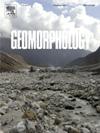Assessing the effects of anthropogenesis on Appalachian flood severity: An eastern Kentucky case study
IF 3.1
2区 地球科学
Q2 GEOGRAPHY, PHYSICAL
引用次数: 0
Abstract
Flooding represents the complex interplay between drainage morphology, landscape hydrology, and precipitation. Precipitation patterns are influenced by interactions between atmospheric moisture circulation and topography, making steep Appalachian terrain vulnerable to extreme storms. Human activity alters surface hydrology and can exacerbate flooding of low-elevation areas where populations are densest. Mountaintop removal is a notable landscape change, but floodplains are also affected by construction of roads and other critical infrastructure and access limitations are addressed by reengineering river channels and building bridges. Though all of these may contribute to flooding, their relative importance remains equivocal. A July 2022 flood in eastern Kentucky provided the opportunity to validate a flood model incorporating major alterations to the landscape, then to iteratively test to determine which, if any, worsened flooding. While bridges, roads, and buildings had only minor effects on flooding despite their proximity to main channels and floodplains, discharge, flood height, and volume results were sensitive to channel narrowing and increased surface runoff facilitated by mountaintop removal sites. Lowering channel capacity decreases discharge and increases flood heights more than mountaintop removal, but mountaintop removal sites result in higher total discharge and operate as the primary contributor to flood volumes in the upper and lowermost portions of the watershed, highlighting a hydrologic sensitivity of the catchment to land use changes. Findings of this study serve to identify human-controlled factors most likely to contribute to future flooding and may thus inform mitigation efforts in eastern Kentucky and similar Appalachian catchments.

评估人类活动对阿巴拉契亚洪水严重程度的影响:一个肯塔基州东部的案例研究
洪水是排水形态、景观水文和降水之间复杂的相互作用。降水模式受大气湿度环流和地形的相互作用影响,使得陡峭的阿巴拉契亚地形容易受到极端风暴的影响。人类活动改变了地表水文,并可能加剧人口最密集的低海拔地区的洪水。山顶的移除是一个显著的景观变化,但洪泛平原也受到道路和其他关键基础设施建设的影响,通道的限制可以通过重新设计河道和建造桥梁来解决。尽管所有这些因素都可能导致洪水,但它们的相对重要性仍不明确。2022年7月,肯塔基州东部的一次洪水为验证洪水模型提供了机会,该模型包含了对景观的重大改变,然后进行迭代测试,以确定哪些(如果有的话)加剧了洪水。虽然桥梁、道路和建筑物靠近主河道和洪泛平原,但它们对洪水的影响很小,但流量、洪水高度和体积结果对河道变窄和山顶移除地点促进的地表径流增加很敏感。降低河道容量比移除山顶更能减少流量,增加洪水高度,但移除山顶的地点导致总流量增加,并成为流域上部和下部洪水量的主要贡献者,突出了流域对土地利用变化的水文敏感性。这项研究的发现有助于确定最有可能导致未来洪水的人为控制因素,并可能因此为肯塔基东部和类似的阿巴拉契亚流域的减灾工作提供信息。
本文章由计算机程序翻译,如有差异,请以英文原文为准。
求助全文
约1分钟内获得全文
求助全文
来源期刊

Geomorphology
地学-地球科学综合
CiteScore
8.00
自引率
10.30%
发文量
309
审稿时长
3.4 months
期刊介绍:
Our journal''s scope includes geomorphic themes of: tectonics and regional structure; glacial processes and landforms; fluvial sequences, Quaternary environmental change and dating; fluvial processes and landforms; mass movement, slopes and periglacial processes; hillslopes and soil erosion; weathering, karst and soils; aeolian processes and landforms, coastal dunes and arid environments; coastal and marine processes, estuaries and lakes; modelling, theoretical and quantitative geomorphology; DEM, GIS and remote sensing methods and applications; hazards, applied and planetary geomorphology; and volcanics.
 求助内容:
求助内容: 应助结果提醒方式:
应助结果提醒方式:


